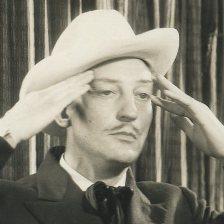Once I got involved watching the Lone Wolf series of movies I soon found myself looking for Inspector Crane and Dickens to pop up, which they did seven times (six and half opposite Warren William)!
(That’s Fred Kelsey as Dickens to the left of Warren William and Thurston Hall as Inspector Crane to our right).
Thurston Hall (1882-1958), who played Inspector Crane, enjoyed a better career than Fred Kelsey (1884-1961), though Kelsey shows up in so many movies that you start to think he’s part of the scenery. Taking a look at their careers on the IMDb, Kelsey appears in an incredible 412 features from 1911-1958, often uncredited but often recognized, while Hall appeared in a respectable 258 various films and television shows himself from 1915-1958.
Among the uncredited spots where Kelsey crops up and I’ve found myself shouting at the TV, “Hey, it’s Dickens” are classics such as Gold Diggers of 1933 (1933), where he shares the frame with Warren William in his brief scene as the cop who’s come to break up Dick Powell and Ruby Keeler, William’s last-ditch effort to stop his younger brother’s marriage which is quickly foiled when Ned Sparks shouts down that he’s no cop, he’s just an actor; Footlight Parade (1933), where he’s similarly the House Detective, this time in a musical number; Twentieth Century (1934), which I don’t personally recall the scene at this time, but the IMDb credits him as the train detective, who I do remember; again as a cop in In Old Chicago (1937), later on in Yankee Doodle Dandy (1942); in Gentleman Jim (1942); The Fountainhead (1949). Kelsey usually shows up for one quick scene as a cop and in all of those roles above, plus the great majority of the films he showed up in, he’s an uncredited extra. Not so when he played Dickens.
Kelsey and Hall did appear in an equal number of Lone Wolf films, seven, though each had one appearance without the other — Kelsey was Dickens in 1940’s The Lone Wolf Strikes, but rather than appearing alongside Hall he was paired with Don Beddoe as Inspector Conroy (Beddoe [1903-1991] showed up in various parts in 6 Lone Wolf films total). Dickens is Dickens, but Beddoe as Conroy is entirely straight-laced, while Hall as Crane is much more effective playing it straight to the bumbling Dickens. No chemistry at all between Dickens and Conroy. Hall appears in 1935’s The Lone Wolf Returns as Inspector Crane — I have this one, but haven’t watched it yet, as the Wolf is not played by Warren William, but by Melvyn Douglas.
Thurston Hall, with his booming voice, more often than not was credited for his performances as they were more substantial performances than Kelsey’s usual walk-on roles. Thus his resume does not boast the impressive titles that Kelsey’s does. Hall also made many television appearances throughout the 1950’s, most notably 5 appearances as Mr. Schuyler in the Topper series.
As Inspector Crane and Dickens, Kelsey played a bumbling cop, who for some reason was the Inspector’s right-hand man. As much as I love Dickens now, he can sometimes even grate on the viewer’s nerves–he is a total idiot. Inspector Crane seemed to be pretty good at what he did, but would always need the assistance of Michael Lanyard, the Lone Wolf, to solve a case. The main reason he required this help was because as soon as Lanyard was placed at the scene he always became the top suspect. And, of course, Lanyard, a reformed jewel thief, was always innocent (even if his own sidekick, his butler Jamison, best and usually played by Eric Blore, always wanted to get back into the game). Dickens always completely believed that the Wolf was guilty, and this usually seemed to sway the Inspector, though Crane was always without any doubt in command of Dickens, dishing out a put down or two towards his underling in each scene they appeared in together. Often the Inspector would “fire” Dickens and Dickens would bumble his way into redeeming himself to be “rehired”. Inspector Crane also enjoyed a more relaxed relationship with the Wolf, often referring to him as Mike and giving Lanyard an opportunity to explain himself.
One of my favorite aspects of the Lone Wolf movies with the Inspector and Dickens is how they just happen to appear in the same out of the way locations where Lanyard has planted himself. (Hmm, maybe this is why they are always so suspicious of Lanyard). In The Lone Wolf Keeps a Date (1941) they run into each other in Cuba, while in Counter-Espionage (1942) they find themselves in London during the bombings of World War II. Sure, we can believe the Lone Wolf being in each of these spots, as he actually has a reason to be in both instances, but when the Inspector and Dickens show up so out of place in each they are guaranteed their first of many laughs.




If there are any fans of Fred Kelsey who haven’t seen Tex Avery’s classic 1943 cartoon Who Killed Who, that would be eight minutes well-spent on YouTube. The unnamed police inspector certainly has Kelsey’s large and hyperactive eyebrows (though dyed jet black), but also has a booming voice, which may have been meant to recall Thurston Hall’s. While mostly a spoof of Old Dark House mysteries, there are a few fleeting similarities with Secrets of the Lone Wolf which MIGHT not be coincidental.